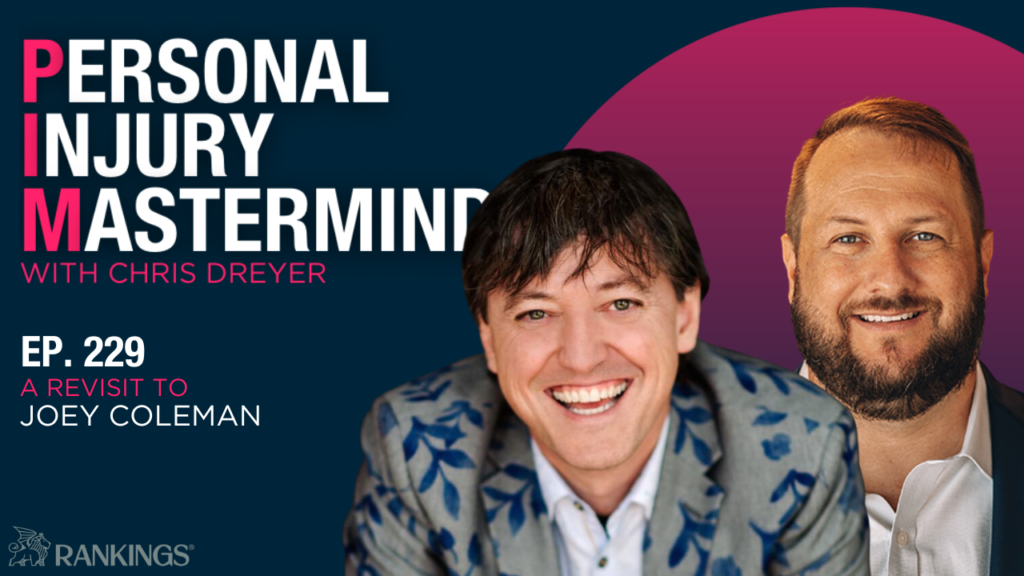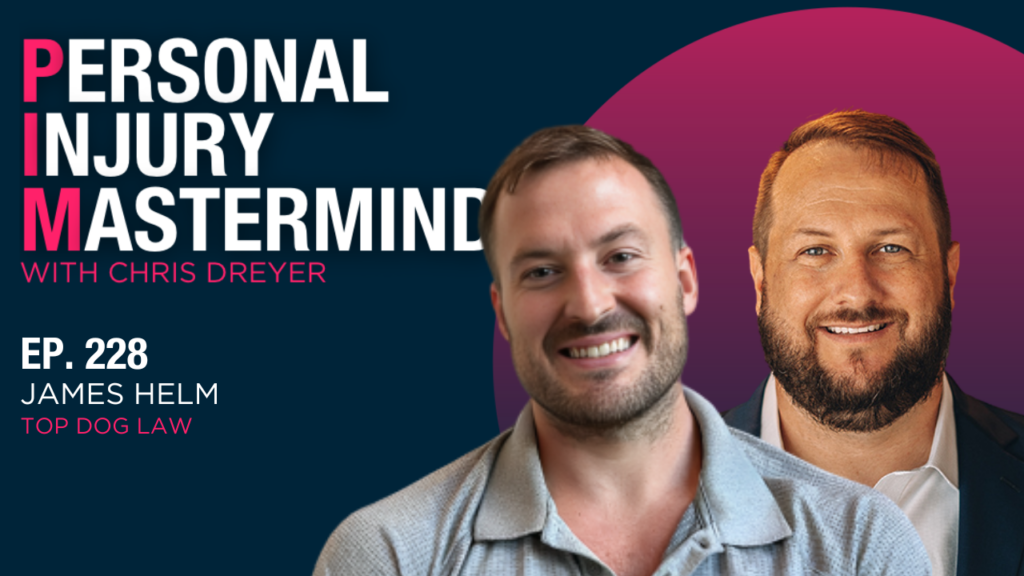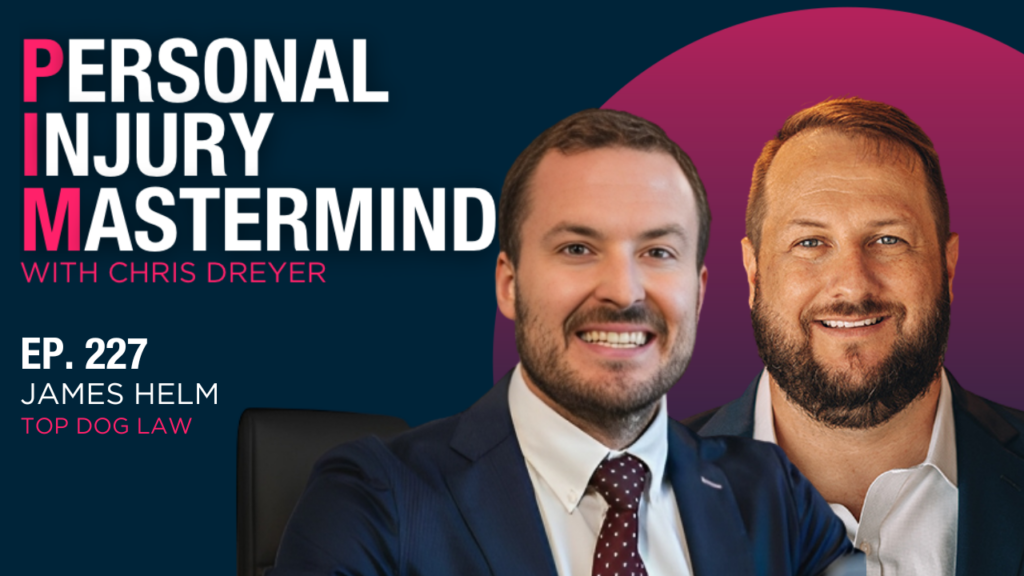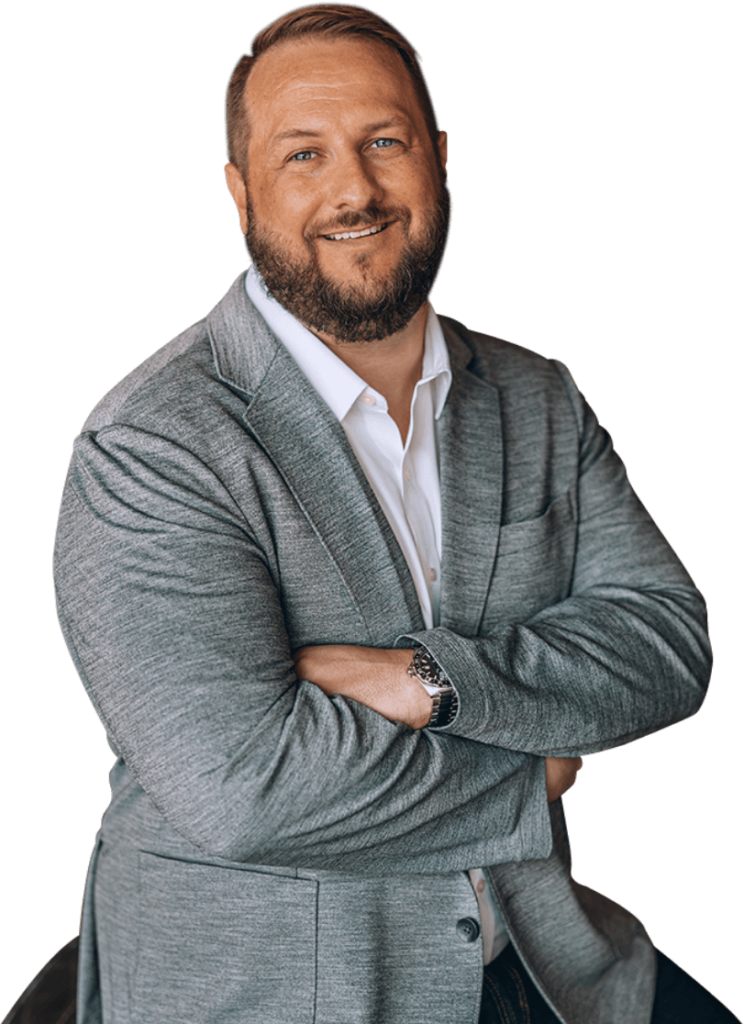Samantha Sparks:
When you’re a bigger brand and you’re like Kleenex, that’s not a person. So if we ever got to a point where we were big enough to not be the sisters-in-law tag team duo, it would probably make more sense. But since right now we want people to trust us as the brand, we’re very careful in who we trust.
Chris Dreyer:
If you’re the face of your brand, be careful who you cozy up to. Every case is an opportunity for a lifetime of value.
Samantha Sparks:
I can have them in and out in two months, and then now I’m their attorney. Same with people who do traffic tickets. You’re not making money off the traffic ticket. You’re making money off of having somebody trust you as their lawyer and see that you can do their job and you can communicate.
Chris Dreyer:
Welcome to Personal Injury Mastermind. I’m your host Chris Dreyer, Founder and CEO of Rankings.io, the preeminent personal injury marketing agency.
Before we get started, if you like what you hear, head on over to Apple or Spotify and pound that five star review button. And if you don’t like what you hear, tell me about it in a one star review, I got a big hug for all my haters, too. Each week, we talk to the best in the legal industry. Ready to dominate your market? Let’s go.
Samantha and Paige Sparks, founders of Sparks Law, gain trust nationwide, touching hundreds of thousands of potential clients. And they do it all spending close to nothing on marketing. How they do it, social media. For every PI lawyer who thinks they’ll never see a return on social media, this episode might be just for you.
Owning a firm was not the driving goal for Samantha Sparks and her sister-in-law Paige. They both wanted to grow with a firm, but they both got burned out and hated working for the weekend. So they came up with a plan. Here’s Samantha Sparks, Managing Partner at Sparks Law.
Samantha Sparks:
She was the brave one. She was like, “I’m going to go out on my own. I’m quitting.” And I was like, “Okay. Ha-ha. That’s never going to happen.”
And then she texted me. I was at work. And she was like, “I just did it. I quit.” And I was like, “Oh Lord. No. I said I wasn’t doing this with you. Stop that. No.” And then a week and a half later, she came over and just was like, “I’ll answer any questions you want. You can have a business plan. We’ll have an operating agreement. Let me do this with you. I already feel so happy and so much pressure’s been taken off.”
So we spent probably an entire two days just going over every little tiny thing. And it was a little bit difficult with the being family, but we came down to there’s a lot more trust in the fact that she’s stuck with me.
So it was really not this great big planned decision, but we both realized if we were going to take the jump, it was the time to do it. So I quit the next day, and we were just off to the races. But I don’t think I could do it with anyone else, especially because we just complement each other really well. And I am totally happy to sit behind a desk, research, crunch numbers all day, where she wants to be out talking to people. And I’m like, “You go do that. I’ll stay here.”
But so far, it’s allowed us to have a lot more honesty that we already had that relationship and that if she messes up, I can call her mom and tell her to get Paige back in line.
Chris Dreyer:
When you first start a firm, it’s like, “How are we going to get business?” And you guys just hit the ground running with social.
Samantha Sparks:
Yes.
Chris Dreyer:
And Paige’s style is different than yours.
Samantha Sparks:
Mm-hmm.
Chris Dreyer:
Paige will be making a coffee drink or something, spill it all over the place, and just roll with it. You have different areas of law that you’re targeting, because most of the PI attorneys listening, specifically the PI attorneys, are like, “No. You can’t get leads from social.” They’re just close-minded to it. They don’t know how to do it. How does the strategy differ for PI and how does it work for you?
Samantha Sparks:
So I think with PI, it makes sense when people are close-minded to it. The person getting in the accident is probably not going to be the one that sees your social media, but they are going to go home and they’re going to tell their friends, they’re going to tell their parents, whoever, or even someone they work with, “I can’t come in. I got into an accident.” And those are the people more often who are like, “Oh, I just scrolled on TikTok. I saw this lawyer. This person said they offer free consultations,” because a lot of people don’t even realize that you can talk to a lawyer no strings attached.
So it’s more we’re getting the awareness out so that those people are there to advocate for us when somebody they know gets into the accident. And then it creates more of that word of mouth trust from the get-go, as opposed to cold calling somebody. And I could sing my praises and I could be chummy with you, but you don’t actually know if I’m going to screw you over the first chance I get. So even though the people who are referring us might not know us, to the person who’s coming to us after getting in an accident, they feel like there is that connection, because somebody they know trusts us even though they have never had that face-to-face with us.
Chris Dreyer:
The other thing that a lot of people are fearful of are the comments and people being mean. I did see one comment that, I got to admit, I did chuckle a little bit, was the, “Who repossessed your photos?”
Samantha Sparks:
Oh my God. And that, see? It’s good. I love that. I don’t know if you saw the response, but they got me on that one. I was like, “You win this round.”
But it’s a weird thing because… And I don’t have enough followers or clout to say I have fans. That’s way out of my league. That’s a Paige thing. But it’s crazy, because those are the little things that make people feel like they know you and make people feel like they trust you. So now anytime I do a video with the empty frames behind me, I have those four or five people who are like, “Oh, yep. There it is. We totally joked around.” I know that’s an inside joke we have when I make that video of getting called out. So you can roll with the punches.
Some people are just rude and I’m not as good as answering quite as politely as Paige. I give them a lot of, “LOLs. Big feelings. I’m sorry you’re so upset about this TikTok you couldn’t scroll past.” But-
Chris Dreyer:
Right.
Samantha Sparks:
She’s a lot nicer than me.
Chris Dreyer:
Yeah, that’s funny. And then the TikTok that we’re referring to, guys, is your office is decorated. I really like your style. I like the green. And then you had these frames, these really nice frames, but you didn’t have pictures in them. And then someone commented, “Who repossessed your photos?”
And you had fun with it. You took it and you rolled with it. And then the thing that’s different, though, is even though you may not have as many followers as other people in the space, your engagement’s super high.
Samantha Sparks:
Yes.
Chris Dreyer:
It is super high.
Samantha Sparks:
It’s a very interesting space to be in, because it’s weird. And some of them, the bigger videos I’ve had, are more consumer protection. But you’ll have 40,000 views and I’ll wake up and be like, “No, no, no. I didn’t mean that. I’m sorry. Everyone stop watching. This is just for the 10 people who actually care about me as a person.”
And I think part of it, too, is the methods that I steal from Paige, the parts of it that work for me. So I do have a cheat sheet and making sure I’m always clear, upfront, like you said. This is who I am. I’m an authority in the matter, but I’m also not going to try to lie to you and make you trust me and then be like, “Surprise. I’m a lawyer.”
And it’s the candor and it’s the willingness to give people information that could benefit them and not benefit me is what I think gets the engagement higher on the videos.
Chris Dreyer:
Yeah. You’re more educational, but it’s in a fun way. A lot of times when I see a lot of the PI, it’s like, “Yeah.” It’s like, “Here are the steps to take after a car accident or what I need to do,” but it’s just so dry and it’s just literally that, whatever, three-second thing in TikTok. It’s just like, “Swipe.”
Samantha Sparks:
Mm-hmm.
Chris Dreyer:
And is there a place for, Monday, we’re posting a motivational quote, Tuesday, we’re doing a Google review that’s… Is there a place for that? Does that work at all?
Samantha Sparks:
Yeah. I think it works in a sense of you need to be posting every day. So our Facebook, especially with, I don’t want to say the older audience, but the older audience, they need those daily reminders, “Hey, I exist. Hey, I exist.” So spacing it out with videos and then a day where you have a Google Review, it helps to be a breather and a reminder of, “We’re giving you these fun videos. We’re giving you this advice, but we’re actually doing work and we’re getting results for people.”
So we use it more as a check-in, I guess. But I don’t think a lot of people on Facebook don’t realize how smart people are. And if all I’m posting is checks and me out on the golf course being a baller, that’s not real and it’s going to make people question me. So we try to just keep it as personable as possible, but it’s not… I wouldn’t say the motivational quotes are going to get you a lot of business.
Chris Dreyer:
Yeah. I hear Gary Vee talk about contextualizing to the platform. And you mention it. Hey, Facebook, it’s like an older audience. Then you’ve got TikTok, which is first of all, they’re growing all audiences, but it started off originated a younger audience. So are you creating one piece of content and then doing it in different ways to contextualize each platform, or what goes into that in terms of the amount that you got to post and for each specific channel?
Samantha Sparks:
We never waste content. So even if I do something that is geared towards TikTok, it’s going on Instagram, because quantity in that sense is going to be more important than quality, because people want that consistency. So we will do things that are specifically geared towards a platform, but it is still going to be used on all platforms, because on the off chance that’s something that gets to somebody on one and doesn’t get to them on the other, but whatever I did on TikTok that they liked and made them go to my profile, they might scroll down three and see that thing that didn’t get pushed to them, but that ends up being whatever they need to trust us.
So it’s more about making sure you get those three contact points with somebody, because that’s the point in which they’ll start to trust you on social media. So things like YouTube, they need to be longer videos for people to actually engage. The short reels don’t really get you anywhere. So if we do three parts on TikTok, we might put all three parts into one on YouTube to get that longer video, to get the way that people like to consume on that.
But we’re never wasting. It’s on every platform. You can go look and see us everywhere no matter what, which, poor Paige, it probably takes 15 minutes for her just to get stuff out on all of my platforms, because I hate having to do that part.
Chris Dreyer:
On social, it’s all about quantity and quality. Five posts are better than one, and not every post needs to be a home run. But how do you know when it’s time to hit other marketing channels?
Samantha Sparks:
I think we’re in the unique position, especially with Paige’s following, that we haven’t had to spend money on marketing and we’re busy. So I think once it hits the point where it stops bringing in the business and where we feel like we’re no longer growing, so if this year we bring in less cases than last year, then that’s when we’re going to have to revamp and change, because the biggest part about being a business owner is being adaptable.
It’s working for us now, but we’re ready to have to flip it over whenever we look at the numbers and suddenly we’re not bringing in PI cases anymore. So maybe we do that for just PI or employment law or consumer law, whatever it is. Our goal is to be able to just roll with the punches in a way.
Chris Dreyer:
You’re the managing partner at the firm and you do do multiple areas of the law, versus a lot of firms, they’ll just go just bankruptcy or just family law or just PI. Is it because of the channel? Social has such a broad audience. Is that why you chose to have a little bit broader practice areas? What was the thoughts behind that?
Samantha Sparks:
So Paige, her love is employment law. So that was a given. We were going to have to figure out a way to do that. And then mine is PI. I’ve always loved it. I think that you get to become a mini expert in a bunch of different things and then forget that, and then the next case comes. So that was something that was important to me. But I also know that, especially in the St. Louis market, there’s 10 million PI attorneys.
So we use consumer protection as a little bit of a way to separate ourselves from that. So people will come in with a debt collection issue or whatever, and they’re quick cases. So I can have them in and out in two months, and then now I’m their attorney. And it’s a way, same with people who do traffic tickets, you’re not making money off the traffic ticket. You’re making money off of having somebody trust you as their lawyer and see that you can do their job and you can communicate.
So that’s where I justify the consumer protection. But I also get a little bit upset with random injustices. So I’ll accidentally sign up a case and be like, “Yeah, I’m going to go get that person for you. How dare they do that?” And then I’m like, “Wait. Am I even going to get any money out of this, or am I just mad that somebody got screwed over by a contractor?” So I think part of it is just that I am maybe a little bit petty about that type of stuff, but it does help.
Chris Dreyer:
You care.
Samantha Sparks:
Yeah. And I feel like when people say, “I care about injustices,” they’re talking about the big overarching civil issues. And I get angry about somebody who was paid up on their car and it got repossessed, because it’s just something I don’t think a lot of people care about. So I get extra angry for them.
So that went sideways, my answer to that. But consumer protection as a concept is very good to help people become familiar with you and to help them start trusting you, so that hopefully, even if they don’t have an employment or a PI issue, they’ll tell their friends about us when they do.
Chris Dreyer:
Your mindset, it’s very similar to Luis Scott over at Bader Scott in Georgia, where he talks about… He’s like, “I’m okay breaking even on cases, because then I’m going to sign cases. And then it leads to more referrals, which is a non-linear equation.” So when you help the tow truck person out, right, and you maybe don’t make much money or these consumer protection, but guess what? If they get in an auto accident or they have something terrible, you’re going to be top of mind.
So on the other side it’s like, “Yes, you are catering to the St. Louis market.” How do you look at things? because your audience is super wide. Your TAM, your total addressable market, is huge and you may get a case in Ohio or California. So what are some of the processes that make that to where you can refer out or using software like Litify or something, or is it really just manually connecting and building those relationships, building that Rolodex?
Samantha Sparks:
It’s so far been manual connections and you know somebody. And people are so helpful usually. So if I know somebody in Kansas, and then they’ll send me someone up to Iowa. There’s always somebody who’s going to connect you to somebody. You just have to be willing to ask. And I think a lot of people don’t want to ask. But the answer’s no if you don’t ask. So it’s like you might as well try.
But we have been very lucky with TikTok lawyers. It sounds completely insane. I never thought that I would ever think TikTok was a good place to meet other lawyers. But we have people in California, and they just drop into your DM and they’re like, “I like what you’re doing. I have a similar style.” And then you slowly can build these friendships online that you can feel comfortable sending people to them, because you’ve suddenly had this whole online relationship with someone you probably won’t ever meet. But we’ve been lucky that we usually are able to connect somebody through personal references. But maybe someday we’ll have to expand, because that does take up a little bit of time.
Chris Dreyer:
Yeah, absolutely. You could do all this work to build the presence yourself, or there’s people that have attention. Right now, my wife is sending me a DM with Alix Earle every other day or someone else. And they have all this attention. Have you approached and thought, “Hey, I don’t…” I guess that that would be a sponsored post. I’m not even sure how you approach that. Have you experimented with any of that?
Samantha Sparks:
We haven’t done that. It’s something that’s come up a time or two. But our approach is based very much in being honest and being as realistic with people as we can. And that’s why we think that it works, is that people see us as people and not some scummy lawyer trying to come and ambulance chase.
So using that, there’s a chance that people could start to think that, “Okay, they’re paying for people to like them. Is that because people don’t always like them?” And when you’re a bigger brand and you’re like Kleenex, that’s not a person. So it’s easy to sponsor something like that, where there’s not a face of the human behind it who is telling you over and over again, three days a week, “Trust me, trust me, trust me, trust me. I’m giving you this information.”
So if we ever got to a point where we were big enough to not be the sisters-in-law tag team duo, it would probably make more sense. But since right now we want people to trust us as the brand, we’re very careful in who we trust to do things with us or for us.
Chris Dreyer:
That’s a different perspective that I’ve never heard of, and that makes complete sense, is a lot of times they’re … Specifically, I’ll just stay on Alix Earle, because she’s top of mind, and the makeup she’s using or the dresses she’s wearing. And she can promote a brand and it’s really easy and natural, versus it would be really weird, I guess, if she was like, “Hey, go follow so-and-so.”
Samantha Sparks:
And I think there’s ways to do it for sure, especially for those big firms that are just everywhere. Even just having them in a post would probably be something. And that might be something that, if we were to do it, it would be that type of scenario where we’re on the live together or doing whatever and using their platform to give our own voice. But I think we’re both a little bit of control freaks and don’t quite want to trust our voice with somebody else, because that could get very precarious.
Chris Dreyer:
Perfect. Makes sense. Makes sense. This has been awesome, Samantha. What’s next for Sparks Law Firm, and then where can people go to connect with you?
Samantha Sparks:
We are still working on getting our YouTube up fully running. We’ve been trying, but doing actual work seems to keep getting in the way. So that’s our next venture is making it so that we’re more accessible to people there and giving them the humanizing content as well as the legal information.
And then we can be found on TikTok. I’m Samantha Sparks STL, and then our law firm, sparks-legal.com. And then emails, phone numbers, all of that’s always on all of the social media and everything. So if people do have a legitimate worry or question, they can reach out to us directly and don’t feel like they have to spill their guts in comment sections.
Chris Dreyer:
Big thank you to Sam Sparks of Sparks Law for all her insight and fresh perspective on social marketing for law firms. Let’s hit the PIMM Points.
First up, social works for PI firms. Why? Because you have to reach people in your potential clients network. You reach people where your client already trusts you. Even if you don’t hit every client directly, there’s still a ton of value, because trust is transitory.
Samantha Sparks:
And those are the people more often who are like, “Oh, I just scrolled on TikTok. I saw this lawyer. This person said they offer free consultations,” because a lot of people don’t even realize that you can talk to a lawyer no strings attached.
So it’s more we’re getting the awareness out so that those people are there to advocate for us when somebody they know gets into the accident. And then it creates more of that word of mouth trust from the get-go, as opposed to cold calling somebody.
Chris Dreyer:
PIMM Point number two, never waste your content or tailor it for each platform. If you do three TikToks that are related, string them together and put them on YouTube.
Samantha Sparks:
Whatever I did on TikTok that they liked and made them go to my profile, they might scroll down three and see that thing that didn’t get pushed to them, but that ends up being whatever they need to trust us. So it’s more about making sure you get those three contact points with somebody, because that’s the point in which they’ll start to trust you on social media.
Chris Dreyer:
I’m Chris Dreyer. Thanks for listening to Personal Injury Mastermind. If you’ve made it this far, it’s time to pay the tax. No, I’m not talking about taking your cash like Big G. I’m asking you for a five star review on Apple or Spotify. Leave me review and I’ll forever be grateful.
If this is your first episode, welcome and thanks for hanging out. Come back each week for fresh interviews where you can hear from those making it rain. And remember, guys, do not share this episode with anyone.


























